Claytonia virginica
One of the first spring flowers to bloom
Claytonia virginica narrowleaf springbeauty
This fragrant perennial native spring ephemeral is a member of the claytonia family, and is one of those flowers that is most anticipated as a sign of spring. This plant produces small, delicate flowers that grow in loose clusters from a narrow stem. The plant has a pair of smooth linear 2 to 8 inch-long leaves. The leaves taper at both ends and usually grow midway up the sometimes-crooked stem. The leaves are slender and lance-shaped. They will continue to grow for a time after the flowering period before going dormant in late spring.
The flowers have five petals and are ½ to ¾ inches in diameter. The petals may be white or pink, with darker pink veins. There can be considerable variation in the color even within the same area of growth. It is not known if the color is genetic or based on environmental conditions. The flowers reflect ultraviolet light making them more visible to insects like bees that can see in that wavelength. There are 2 sepals and 5 stamens with pink anthers. Each stamen is opposite a petal. The flowers often close at night and on cloudy days.
The plants grow 3-12 inches tall and are often abundant in moist woodlands from March to May. The plant grows from an underground tuber (corm) that resembles a small potato. This tuber has a sweet, chestnut-like flavor and was used by Native Americans and early colonists as food. Over-harvesting for food does, however, diminish their value as a beautiful spring wildflower and is not recommended and it does take a lot of work to gather enough to make a meal.
The range of this species is throughout eastern North America as far west as Minnesota and Texas and as far north as southern New England and southern Ontario. It seems to be less abundant in the Southeast and absent in Florida. In those areas there is a closely related flower called the Carolina beauty (Claytonia caroliniana). The Eastern spring beauty is endangered in Massachusetts and apparently has become extirpated in Rhode Island. It is documented in most counties of Pennsylvania.
The fruit is a small capsule, enclosed by a calyx and contain several shiny black seeds. Although the flowers are small, they can make a spectacular appearance when they grow in large colonies.
Springbeauty grows best in rich, fertile and moist soils and does well in partial shade. It can be found in both woodlands and in open meadows. In some areas it is given the common name of fairy spud or meadow beauty.
Habitat & Range
Common in moist woods and meadows. Prefers partial shade, alluvial soil and wet to mesic conditions.
Present throughout the state.
Range: Found throughout eastern North America as far west as Minnesota and Texas and as far north as southern New England and southern Ontario.
| EMP: | FAC |
|---|---|
| NCNE: | FACU |
Phenology
Flowers early March through May. Blooming last for 1 to 2 months.
Characteristics
Inflorescence loose raceme bearing 5 to 19 flowers; lowest pedicel subtended by a small, leaf-like bract
Flowers white or white with pink veins on slender pedicels (stalks); 5 petals, 5 stamens with pink anthers opposite the petals; 2 green to purplish sepals formed from the calyx which persist onto the seed capsule; ½″ across
Leaves one pair of opposite cauline leaves; linear to linear-lanceolate; entire (toothless), smooth; blade not narrowing significantly at base; 2.5-5″ long avg, can grow up to 12″, abt ⅖″ wide
Stem smooth, slender, rounded; arises from tuber; pale green to reddish-purple
Fruit small, 3-valved round capsule; 3 to 6 seeds (1 to 2 seeds per capsule); 3-4mm across; seeds are expelled from capsule when ripe
Height 3 to 12 inches
Similar Species
Claytonia caroliniana
wider leaves than C. virginica
Plant Codes
S-rank: S5 (Secure)
G-rank: G5 (Secure)
Ecology
Primary pollinator of Virginia springbeauty is the Andrenid bee, a specialist pollinator that relies particular on springbeauty species for pollen. Other kinds of bees visit the flowers for pollen and nectar, including honey bees, bumblebees, little carpenter bees, mason bees. Many flies also visit the flowers for nectar, including syrphid flies, the giant bee fly, flesh flies, and Calliphorid flies. A few butterflies and skippers also visit the flowers for nectar. Occasional transfer of pollen can occur by butterflies.
Ants often disperse the seeds.
The corms of springbeauty are dug up and eaten by some small rodents, such as mice and chipmunks. Deer occasionally browse the foliage.
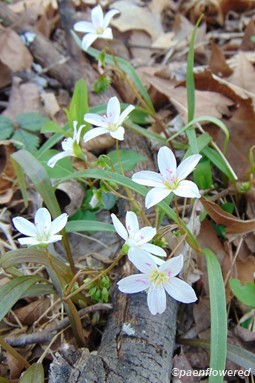
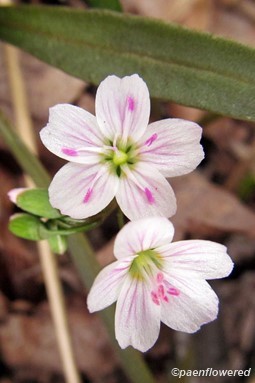



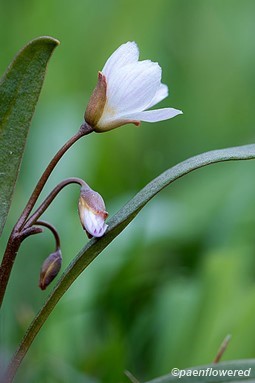
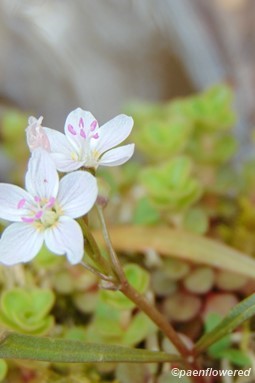
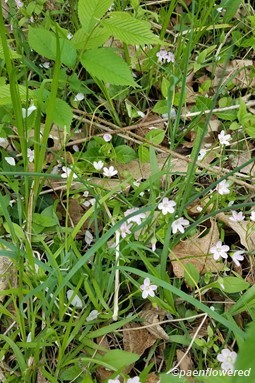
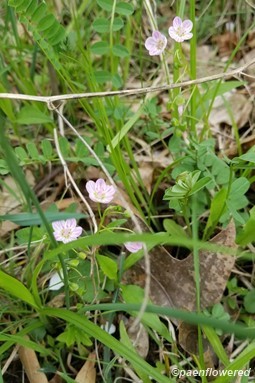


Comments
Have you spotted this plant in your area? We'd love to hear about your experience! Share your comments or questions about the plant below. Comments are moderated before posting.